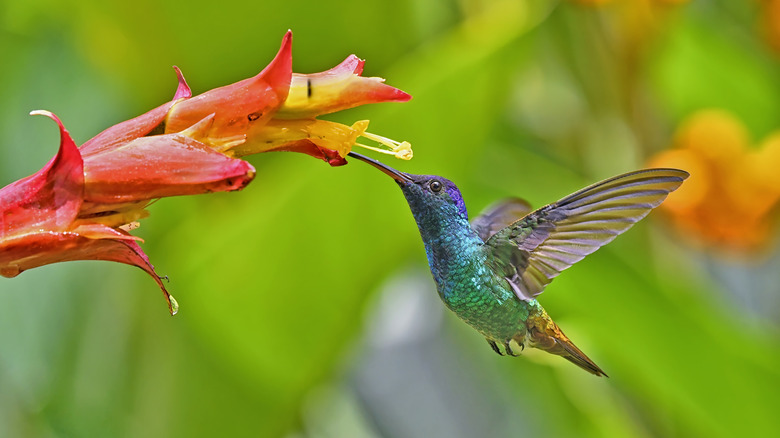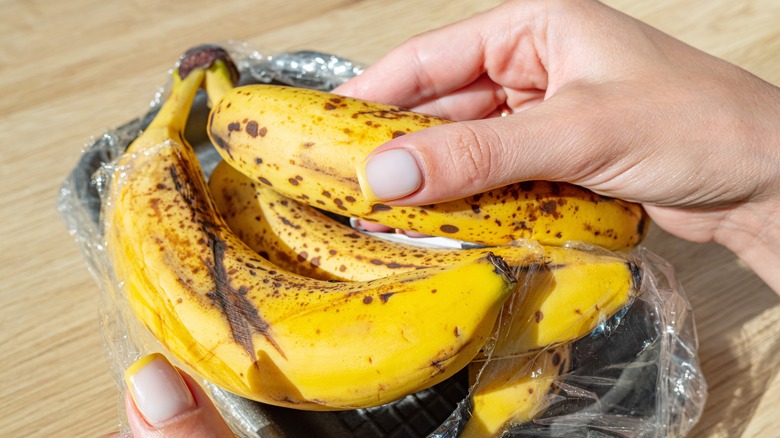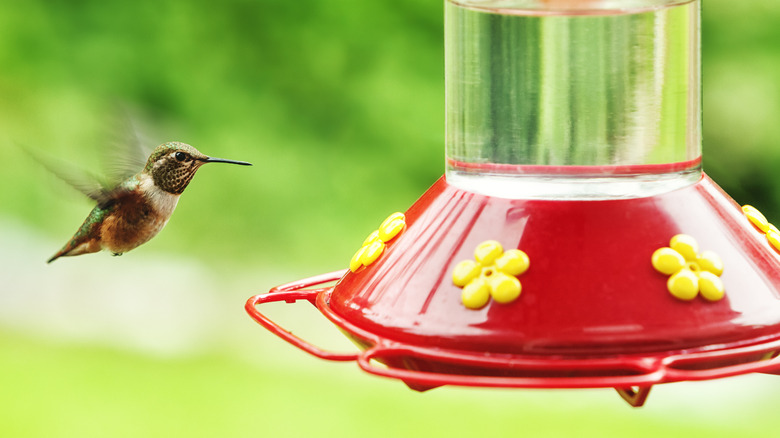Don't Toss Your Overripe Bananas & Use Them To Attract Hummingbirds Instead
Hummingbirds have long captivated humans with their shimmery feathers, the thrum and speed of their wings, and their magical ability to elude sight. To increase the chances of spotting them, people set up hummingbird feeders and plant flower bulbs that attract them. They also try to figure out the best trees for hummingbirds to nest in. If you're looking for more ways to attract these iridescent creatures to your yard, you only need to grab a few overripe bananas from your fruit bowl.
Contrary to what many people believe, hummingbirds don't live off of a diet of nectar — whether from flowers or feeders. In fact, according to the Wildlife Resources Division of Georgia's Department of Natural Resources, 80% of a hummingbird's diet consists of insects and other invertebrates. Although hummingbirds love their sweets, yummy insects like mosquitoes and small spiders are what provide them with sufficient sustenance.
And if you're wondering where bananas come into play, these fruit are beloved by fruit flies, which — among other insects like ants, aphids, gnats, and mites — are a source of abundant nutrients and vitamins for hummingbirds. The more ripe the banana is, the more fruit flies will be attracted to it.
Nectar with a side of fruit flies
Every second in flight, hummingbirds can flap their wings up to 90 times, which means they are constantly burning calories and needing to refuel every 10 to 15 minutes. Similar to how women need to consume more calories when breastfeeding, hummingbirds who are feeding their babies also need to have a protein-rich diet to adequately pass nutrients to their offspring. This could mean eating as many as 2,000 insects each day. When hummingbirds are migrating, their consumption of insects also increases, compared to other stages of life.
To offer hummingbirds a serving of fruit flies, place an overripe or rotting banana on your compost pile, on a small dish in your yard, or hang banana peels in a mesh bag near a feeder. Fruit flies, which are attracted to decomposing fruit and vegetables, feed on the surface of these foods. They are especially active during the warm seasons of spring and summer, sneaking into our homes as stowaways on bananas.
Setting up and maintaining a hummingbird feeder
If you don't already have a hummingbird feeder to attract birds to your yard, you can either purchase one or make your own with a plastic water bottle, small plastic tub, and string. Hummingbirds head north in late winter to early spring and back south in late summer to early fall, so be sure to have your feeders out within this timeframe.
These territorial creatures are small but mighty, exhibiting their feistiness when other hummingbirds show up at the same feeder. To keep the peace, set up multiple feeders, ideally out of sight from one another. Keep them in the shade to keep the nectar from spoiling, especially on hot days. To make the nectar, dissolve ¼ cup of white sugar in 1 cup of boiling water. Let it cool before pouring it into the feeder.
Since you're providing the birds with food, it's important to maintain proper hygiene for the feeders. This means scrubbing them on a weekly basis with warm water and white vinegar to remove build-up. You can also use diluted bleach (one part bleach to nine parts water) as a cleaning solution, or soak the feeder for an hour in a 1:4 vinegar-water solution. In addition to weekly cleanings, change out the nectar several times a week.


